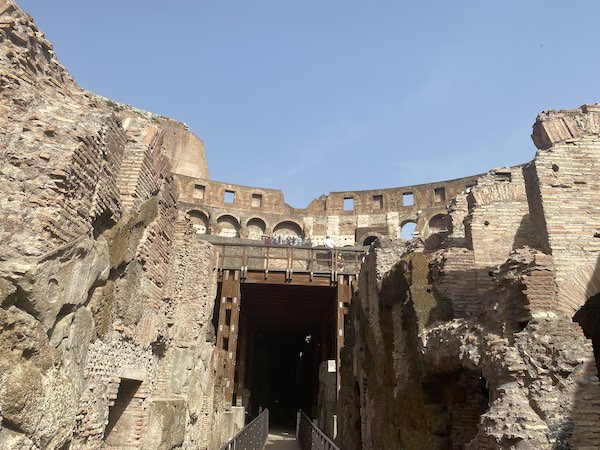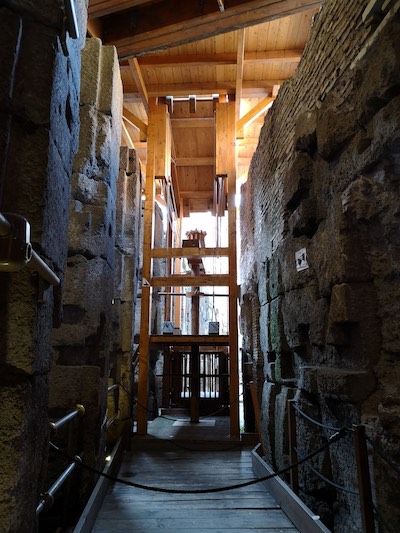Interesting, fun and fascinating facts about Roman gladiators + myths about gladiators in Ancient Rome.
Roman gladiators have fascinated generations.
Ancient sources tell us about the excitement that the appearance of gladiators and gladiator fights boughs to the people of Rome, and the mystique around these fighters keeps inspiring artists and filmmakers to this day.
The popularity of Roman gladiators means we know many facts about them but also that many things about their lives and the games got romanticized and, ultimately, distorted.
Distinguishing facts from fiction about Roman gladiators is not always easy; however, we have a sufficiently large number of ancient sources to know at least some things about them that historians and archaeologists consider as facts.
We talked before about how gladiator games were a popular form of roman entertainment, maybe the most popular of all.

Today, we look at some fun and interesting gladiator facts, such gladiator names, weapons, training, origins, and names of the most famous gladiators of all time.
You can use this for your studies or before you visit the Colosseum, the Roman amphitheater that hosted gladiator fights for five centuries!
I am a Roman history graduate from the University of Rome and I have gathered the info on this article from ancient and modern sources mentioned at the end of this post.
By the end of this article, you should be able to answer the questions:
- Who were the gladiators? Where gladiator slaved? Were there woman gladiators?
- What weapons did gladiators use?
- What was gladiator training like?
- What wild animals did gladiators fight?
- Did gladiators fight to their death?
- Who were the most famous gladiators in Ancient Rome?
Top Tip! The best way to learn about Roman gladiators is by taking a tour of the Colosseum led by an archaeologist. You can find my recommended Colosseum Tours here.
The origins of Roman gladiators and gladiator games
Roman gladiators were professional ancient roman fighters.
Ancient sources tell us that gladiators existed in Rome since the early days of the Roman Republic and probably have roots in Etruscan times.
According to author Tertullian, gladiators in origin were war prisoners who would perform fights during funerals to honor the dead (funeral games were traditional both in Rome and Ancient Greece).
There is no consensus on this origin; however, ancient authors talk about gladiator fights in both Republican and Imperial times and usually consider them a constant and important aspect of ancient Roman culture.
Historians believe the first gladiator fight not connected to a funeral happened in 264 B.C. and that gladiator games became public under Marius in late I century B.C. (105 or 103 B.C).
The term gladiator comes from the Latin word gladius, a type of sword.
Gladiators used several different types of weapons (see below) but the gladius seems to have been the most ancient and, therefore, the most iconic.
While we don’t have written memory of the first gladiator game in Rome, we have memory of the last one. The last gladiator game in Ancient Rome took place in January 401 A.D.

Who were the gladiators in Rome
Gladiators were people from different walks of life.
In many cases, gladiators were slaves or war prisoners; however, this was not a rule.
Gladiators weren’t always slaves and we have many sources telling us of free men participating in gladiator games.
While not always salves, roman gladiators usually joined the games out of need more than choice.
We know that gladiators were private citizens with a life sentence, people overwhelmed by debt, criminals and, occasionally, free men attracted to the arena by the promise of richness and honor that expected the most successful ones.
Being a gladiator, however, came at a price.
As well as the inevitable risks, gladiators were considered infames, people at the bottom layer of society.
While on duty, there were also limitations to personal freedom.
Ancient sources tell us that a fighting gladiator owed his services to his trainer, who had power over him and would own it as property.
This applied to free men too; this special status goes by the name Auctoratus.

An interesting passage in the work of Juvenal tells us the type of judgments Romans had for gladiators.
When telling the story of Gracchus, an aristocratic free man who joined the gladiators’ ranks, Juvenal doesn’t spare words of contempt.
He says Gracchus was the shame of Rome and he commiserated the adversary who had to fight him.
The reason why a free man would voluntarily become a gladiator was fame.
Victorious gladiators were like modern day celebrities and heroes, in a way not entirely dissimilar to that of bullfighters in Spain.
It is interesting to know that gladiators in Ancient Rome were not just men but women too.
We know about ancient female gladiators from Juvenal who, however, had terrible contempt for them and the shows in which they performed.
Romans considered modesty and purity essential virtues in women (the roman legend of Lucretia is a good example).
Performing in public was considered a dishonor and an offensive to Roman decorum.
How to become a gladiator (Sacramentum Gladiatorium)
Becoming a gladiator wasn’t to be taken lightly.
When committing, by will or necessity, to gladiator life, gladiators had to take an oath that we read in Petronius Satyricon 117: Uri, vinciri, verberari, ferroque necari [I will accept to be) burned, tied, beaten and killed by the sword.
One sworn in, gladiators would fight in games, which could happen several times a year or more sporadically, depending on events and celebrations.
Gladiator Training and diet
Gladiators went through intense training in gladiator schools called Ludi.
A fantastic example of a gladiator school is Ludus Magnus in Rome, just beside the Colosseum and still visible today.

The manager of the gladiator school was called lanista, while the person organising the shows was called editor.
Gladiator school provided gladiators with cells to sleep, food and medical care during training and after the fights.
The gladiators’ diet seems to have been based on pulses, vegetables, nuts and dried fruit. Meat was scarce but dairy, honey and wine were all included.
Fun fact! Did you know that you can train like a real gladiator? Gruppo Storico Romano runs Gladiator School in Rome and is it great fun. The school is for all ages and you can go with kids as young as 6. You can find here >> our full review of Rome’s Gladiator School with kids
Types of gladiators
Gladiator training involved different types of fighting and weapons.
Ancient sources tell us about the different types of gladiators:
- Equites would enter the area on horseback, then finish the fight on foot
- Murmilli had large shields and a helmet
- The Thraex had a small square shield that covered his torso and fought with a short sword called a sica
- The hoplomachus carried a smaller round shield
- Retiarii had a shoulder-guard (galerus) and carried a rete (a weighted net) and a fascina (a trident) as their weapons
- The Secutor was heavily armed with a large shield and sharp dagger.
- Velitus fighters fought in groups and had no armour
- Samnites carried a short sword and shield
- Dimachaerus warriors wielded two swords
- Laquerius warriors carried a noose and a trident
- Bestriarii would fight wild animals
Most common gladiator weapons
Gladius – a short sword
Retes – weighted nets
Fascina – three-pronged trident
Siccae – a short scimitar blade
Pugio – a short dagger
Gladius graecus – a leaf-shaped sword

Gladiator clothing
For practicality and performance power, gladiators used to wear minumal clothing.
Ancient sources tell us the names and characteristics on some of the main clothing items for gladiators:
- Subligaculum – canvas loincloth
- Gladiator sandals
- Manicae – arm protection
- Balteus – a sword belt
- Cingulum – wide leather belt with metal plates
- Ocra – metal leg guard
- Helmets (different types for different fighting styles)
- Galerus – shoulder guard
Types of gladiator fights
Gladiators engender in different types of fights, some men vs. men, some involving a compact between men and wild animals.
In the case of men vs. men, gladiators were usually paired by skills and armor, in a way that produced the most spectacular fight possible.
Animal vs men fights included animals of all sorts of provenance.
Animal hunting shows were called venationes and were among the most popular type of public pastimes in Ancient Rome.
The gladiators fighting wild animals were called bestiarii.
The most common types of animals used in gladiator fights were big felines such as tigers and lions, elephants, but also deer and camels.

How did gladiator fights end
One of the most common misconceptions about gladiators is that they would either win or die in combat.
In reality, gladiators didn’t always fight to the death.
Gladiators were too expensive an asset to just be sent to die so it was rare that the end of combat would see a gladiator sent to death simply for losing.
If this happened, it often had to do with a gladiator who fought cowardly on unfairly.
At the end of a roman gladiator fight, several things could happen:
The victorious gladiator would receive a palm trophy and his owner a large sum of money.
If he had gained freedom, he would also be sent off with a rudis, a wooden sword symbolizing discharge from service.
Victorious gladiators left the arena via the Porta Triumphalis (triumphal gate).
A defeated gladiator would have a reprieve (missus) or be forced to fight again and would leave the arena via a gate called Porta Sanavivaria.
The fallen would be carried through Porta Libitinensis: their armor would be taken away in the spoliarium, and returned to the gladiatorial school.
How often did gladiators fights
Ancient roman games happened at different moments in time in ancient Rome.
In most cases, games accompanied celebrations initiated by public authorities or the Emperor or religious ceremonies.
It is interesting to learn how the games’ frequency and nature changed over time.
During Republican times, gladiator games (munera) were privately financed by the family presenting them and the frequency varied .
Under Augustus, in the I century AD, gladiator games became responsibility or magistrates called praetores, and were limited to a number of two per year and sixty pairs (Dio, LIV.2.4)
Under emperor Trajan however, in the 2nd century AD, we know of gladiator games that lasted several weeks and we have many more examples of long celebrations, which make hitorians believe there was no hard and fast rule about this.

How were the gladiators treated
How gladiators were treated depended largely on their success.
Victorious gladiators would be much beloved by the crowds and would bring significant riches to their trainer.
Trainers were therefore incentivized to keep their best gladiators healthy and in shape, as their loss would have been a huge financial hit.
Disappointing gladiators on the other hand were disposable: in case of a lost battle, they could be handed to the winner for his fate to be decided.
Gladiator myths and false facts
The myth of the thumb down to send gladiators to their fate
One of the most common misconception about gladiators concerns the gesture of the thumb down.
In many representations, we see gladiators in the arena facing a Roman Emperor or excited spectators with a thumb down to signify death.
In reality, the only hand gestures connected with gladiator fights we have historical memory of, are the thumb inside the closed fist, the thumb up (in Latin: versus pollex) and the horizontal thumb.
Historians believe the thumb symbolized the swords.
Therefore the closed fist meant the end of the fight/ sparing the loser, while the horizontal thumb and thumb up were likely used to declare a death sentence.
The myth of the thumb down as a sentence in the Roman Empire was popularized by the famous painting by Jean-Léon Gérôme (1872) and then used in many films and representations to highlight the randomness and cruelty of the gladiators’ destiny.
Gladiators didn’t enter the arena saying Morituri te salutant
Another myth concerning gladiators is that they would address the roman emperors with the expression Ave Caesare, Morituri Te Salutant (Hi, Caesar, those who are about to die salute you) before fighting.
It seem that this sentence was pronounced once, in front of emperor Claudius, before a naval battle.
However, it wasn’t traditional and possibly a one-off occurrence.
The most famous roman gladiators of all times
Who was the greatest gladiator of all times? Sources recorded several names.
Priscus and Vero, I century A.D. famous gladiators and friends who found themselves fighting each other.
The legend tells us the fight went on for so long and it was so good that Emperor Titus gave them both the rudis, and set them free.
Marcus Attilius, famous gladiator and also remarkable as originally a free man
Flamma, a Syrian prisoner known for fighting inside the Colosseum
Spartacus, known as a gladiator and for leading a revolt against his captors
Watching a gladiator show in Rome today
Gladiator shows in Rome are ognamized by one historical group that reenacts what a gladiator fight would have been like. The group is called Gruppo Storico Romano and currently holds event in the theme park Roma World, immediately outside of Rome.
I hope you enjoyed this quick overview of facts about ancient Roman gladiators and it helped answer all your gladiators questions. Happy studying!
Sources for this article include: Cassius Dio, Petronius, Tacitus, Juvenal, Tertullian (ancient sources) and modern works by historians and academics including Giacomo Devoto, Carla Ricci, Fik Meijer.
